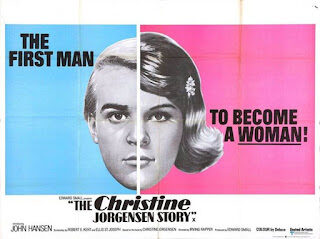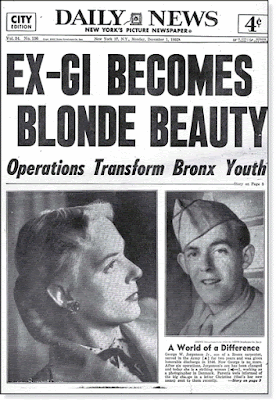We continue, from part 1 and part 2, considering an article by Jack Drescher, M.D., who is a psychiatrist and psychoanalyst, wherein he complied some interesting data with regards to, as he states it within his relevant paper’s title, “Queer Diagnoses: Parallels and Contrasts in the History of Homosexuality, Gender Variance, and the Diagnostic and Statistical Manual” which was published in the Archives of Sexual Behavior, April 2010 AD, Volume 39, Issue 2, pp 427-460. I will add bold and underlining emphasis for emphasis.
Here is a little info on the history of sex change operations / sex reassignment surgery:
By the 1920s, physicians in Europe had begun experimenting with sex reassignment surgery (SRS)…1952 New York Daily News headline: “Ex-GI Becomes Blonde Beauty”…For those who eventually would come to identify as transsexual, increased public discussions of sex reassignment and gender identity would provide them with a way to put a name to their feelings and desires. As a result, a presentation of gender (Stoller, 1985) once considered exceedingly rare would gradually become more commonplace.
Many physicians and psychiatrists criticized using surgery and hormones to irreversibly—and in their view incorrectly—treat people suffering from what they perceived to be either a severe neurotic or psychotic, delusional condition in need of psychotherapy and “reality testing.”
With reference to Iran, Drescher notes that “While homosexuality is illegal there, it is estimated that about 150,000 transsexuals live in Iran, which hosts more sex-reassignment surgery (SRS) than any nation besides Thailand.” He then references Jesse Ellison’s February 19, 2008 AD Newsweek article, “Film Explores Iran’s Transsexuals”:
Explaining the apparent paradox, one Muslim cleric says that while homosexuality is explicitly outlawed in the Qur’an, sex-change operations are not. They are no more an affront to God’s will than, for example, turning wheat into flour and flour into bread. So while homosexuality is punishable by death, sex-change operations are presented as an acceptable alternative—as a way to live within a set of strict gender binaries, as a way to, well, live like others. The tragic aspect comes through in discussions with patients and their reluctant parents in the waiting room of Tehran’s pre-eminent sex-change surgeon, Dr. Bahram Mir Jalali, where it becomes clear that some feel pressured, not free, to become transsexuals. Asked if he would be preparing for surgery were he living outside
Iran, one young man says, “No. I wouldn’t do it. I wouldn’t touch God’s work.”
Jack Drescher also wrote:
Rigid gender beliefs often flourish in fundamentalist, religious communities…biblical prohibitions against homosexuality are, at times, framed in language that describes men as transgressing their “natural” (that is, God-given) gender roles…
This last point is interesting because many homosexual activists do not seem to understand that if God is then God is, as the Declaration of Independence puts it, “nature’s God” and thus, God determines that which is natural as a natural result of His having created it. Homosexual activists, such as Rev. Dr. Mel White (see Open Reply To Rev. Dr. Mel White On Christian), claim that texts such as “even their women changed the natural use into that which is against nature. And likewise also the men, leaving the natural use of the woman, burned in their lust toward one another; males with males working out shamefulness” (Romans 1) refer to a person’s subjective view of themselves; their own desires, orientations, etc. yet, as Drescher rights ups it, “‘natural’ (that is, God-given).”
He also wrote:
…there are…altruistic reasons for turning “sinners” into “patients”: the medical model’s promise of hope for treatment and cure. An ill person was not necessarily responsible for his or her “symptoms,” and, in the best of circumstances, would benefit from therapeutic compassion rather than religious judgment and condemnation…
He also chronicles the following:
In 2005, United Church of Christ became the first mainline Christian denomination to support same-sex marriage. Major religious groups that permit same-sex unions but that do not give them the same status as marriage include the Episcopal Church, the Evangelical Lutheran Church, and Reform Judaism. Reform Judaism now trains openly gay and lesbian rabbis…
One wonder if a time comes when idolatry becomes mainstream hip, trendy and fashionable, the United Church of Christ, the Episcopal Church, the Evangelical Lutheran Church, Reform Judaism, et al. will support it and put clergy-personages in place who will promulgate it.
Jack Drescher notes that “clinicians” Stephen B. Levine and Anna Solomon wrote:
“Our work begins with the belief that GID is a fact of nature,” (p. 51), by which one might presume they think of transgenderism as a natural condition, they nevertheless assert:
1. In a nosological [from nosology: the branch of medical science dealing with the classification of diseases] sense, GID are [sic] forms of psychopathology; 2. Gender identity disorders are typically co-morbid with other psychopathologies; 3. The promotion of civil rights for the transgendered can obscure professional perceptions of psychopathology;4. Ethical obligations require professionals to communicate the uncertainties about the long-term outcome of gender transition and sex reassignment surgery (SRS) [Levine, S. B., & Solomon, A. (2009). Meanings and political implications of ‘‘psychopathology’’ in a gender identity clinic: A report of 10 cases. Journal of Sex & Marital Therapy, 35, p. 41].
Focusing upon the statement that “Our work begins with the belief that GID is a fact of nature” note the following:
Moberly (1983a) asserts, “Traditionally, the Christian faith has regarded homosexual activity as inappropriate, as contrary to the will and purposes of God for mankind…it seems to the present writer that one may not avoid the conclusion that homosexual acts are always condemned and never approved. The need for reassessment is not to be found at this point” [Moberly, E. (1983a). Homosexuality: A new Christian ethic. Cambridge, England: James Clarke, p. 27]…
Nicolosi (1991) sees human sexuality through a metaphysical lens that elevates heterosexuality and denigrates same-sex relationships:Each one of us, man and woman alike, is driven by the power of romantic love. These infatuations gain their power from the unconscious drive to become a complete human being. In heterosexuals, it is the drive to bring together the male-female polarity through the longing for the other-than me. But in homosexuals, it is the attempt to fulfill a deficit in wholeness of one’s original gender [Nicolosi, J. (1991). Reparative therapy of male homosexuality: A new clinical approach. Northvale, NJ: Aronson, p . 109].
Some significant contrasts between reparative therapists and DSM-V Workgroup members who treat gender variant children are that none of the latter practice from a religious orientation, their published works do not explicitly cite religious dogma, they do not think homosexuality is a sin or an illness, they do not think it is wrong to be gay, they do not see a gay outcome as a treatment failure, they do not call what they do reparative therapy, and they do not reference reparative therapy literature in support of their clinical approaches.
Note that, amongst other issues, Jack Drescher specifies that the “DSM-V Workgroup members” do not “practice from a religious orientation” and “do not explicitly cite religious dogma.” However, as evidenced by the example of Levine and Solomon, they do assert secular dogma such as beginning ones research with a presupposition, “Our work begins with the belief that GID is a fact of nature.” Well, it is a “fact of nature” in as far as it does exist but is it “fact of nature” in that it is natural (as in normal, ethical, beneficial, etc.)?
Moreover, to not “practice from a religious orientation,” to “not explicitly cite religious dogma,” to “not think homosexuality is a sin or an illness,” to “not think it is wrong to be gay,” to “not see a gay outcome as a treatment failure,” etc. is to be dogmatic. That is to say that they may not cite religious dogma but do cite the secular dogma de jour. Also, note that Jack Drescher makes reference to “religious or other theoretical beliefs.”
…generational changes in the organization, APA gradually became a more socially conscious group. Given psychiatry’s historical role in stigmatizing homosexuality in mind, and thanks to the efforts of a growing number of openly gay, lesbian, and bisexual psychiatrists coming out in the organization (Ashley, 2002; Barber, 2003, 2008; Hire, 2001), APA continued to expand its public positions regarding gay and lesbian civil rights…
In 1998, APA issued a statement opposing “any psychiatric treatment, such as ‘reparative’ or ‘conversion’ therapy, that is based on the assumption that homosexuality per se is a mental disorder or is based on the a priori assumption that the patient should change his or her homosexual orientation.”In 2000, APA strengthened the statement, recommending, “ethical practitioners refrain from attempts to change individuals’ sexual orientation (American Psychiatric Association, 2000b)”…
The Caucus of Gay, Lesbian, and Bisexual Members of the American Psychiatric Association (CGLBM-APA) was established in the mid 1970s and is active within APA to this day.
In 1978, APA created a task force on gay and lesbian issues that in 1981 was upgraded to a standing Committee on Gay, Lesbian and Bisexual (GLB) Issues. While originally charged to focus on GLB issues, a revised charge was approved and updated in 2004 to include trans issues as well.
Due to a 2009 restructuring of APA governance, the Committee on GLB issues (among scores of others) was ‘‘sunsetted’’ and the GLB Caucus is now the de facto APA component charged with addressing LGBT issues.
The next segment is titled, “Causes and choice of homosexuality.”



